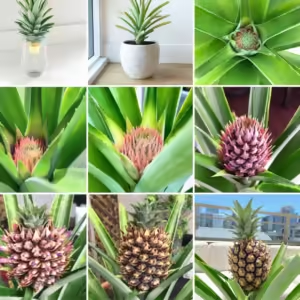Understanding Pineapple Plants
Also known as Ananas comosus, pineapples grow on a plant that belongs to the bromeliad family. This unique plant features long, spiky leaves arranged in a rosette shape, growing close to the ground. Typically, each pineapple plant produces a single fruit at its center, which develops from a cluster of small flowers.
The process begins when the plant flowers and the tiny flowers fuse to form the characteristics of the pineapple. As the fruit matures, it gradually changes from green to a bright golden-yellow color, indicating ripeness. The plant thrives in warm, tropical climates and reaches a height of about three to four feet. Understanding the plant’s unique structure and growth process showcases the complexities of this beloved fruit, from cultivation to harvest.
Where Do Pineapples Grow?
Pineapple plants require warm temperatures and ample sunlight for successful growth, thriving in tropical and subtropical climates. Ideal conditions include temperatures between 65°F and 95°F (18°C to 35°C) and well-drained soil that retains some moisture.
Regions known for pineapple production include Hawaii, Malaysia, Thailand, the Philippines, and Costa Rica. Hawaii’s volcanic soil and favorable climate make it an ideal location for pineapple farming. Malaysia, Thailand, and the Philippines leverage their rich agricultural traditions and suitable weather, leading to significant exports. Costa Rica has also become an important player in the pineapple industry, supplying markets worldwide.
In these areas, the careful cultivation of pineapples supports local economies by ensuring the year-round availability of this delicious fruit. Additionally, many regions emphasize sustainable farming practices, further enhancing the quality of pineapples produced for both local and international markets.
How Pineapples Grow
Pineapples have a fascinating and unique growth process, starting with planting and culminating in the development of the fruit.
Planting: Pineapples can be propagated from the crown of a mature fruit. To prevent rot, the leafy top is cut off and allowed to dry for a day or two before being planted in well-draining soil, either in a pot or directly in the ground. This method not only encourages the growth of new pineapple plants but also promotes sustainability by utilizing parts of the fruit that would otherwise be discarded.
Growth Cycle: The growth cycle of a pineapple plant typically takes between 18 to 24 months from planting to fruiting. Initially, the plant forms a rosette and focuses on developing its tall, spiky leaves. After several months, it begins to flower, with small, tubular flowers clustering together to form the pineapple fruit.
Once the flowers bloom and are fertilized, they merge to develop into a single pineapple. The fruit gradually grows larger and changes color over several months, transitioning from green to a vibrant golden-yellow as it ripens. This entire growth cycle reflects the patience and care required in pineapple cultivation, ultimately resulting in the delicious fruit we enjoy.
Common Misconceptions About Pineapples
There are several misconceptions about pineapples that can lead to confusion about how they grow. Here are some key points to clarify these misunderstandings:
- Growth Habit: Pineapples grow on a short, ground-level plant known as Ananas comosus, unlike tree fruits such as apples or oranges. This plant features a rosette of long, spiky leaves and typically reaches heights of only three to four feet. This low-growth habit differentiates pineapples from fruits that develop on taller trees.
- Tropical Appearance: The tropical appearance of pineapples can contribute to the misconception that they grow on trees. Leading many to associate them with fruit-bearing trees common in tropical regions, their vibrant color and spiky crown give them an exotic look.
- Crown Similarity: However, this crown is an integral part of the fruit itself, not an indication of tree-like growth. The crown of leaves on top of the pineapple resembles a small tree, which can further confuse people.
- Single Fruit Production: Pineapples typically produce only one fruit per plant, emerging from a cluster of flowers. This contrasts with many tree fruits that can develop multiple fruits from a single tree, reinforcing the notion of pineapples as a distinct category of fruit.
- Cultural Associations: Pineapples are often featured in tropical imagery, which enhances the misconception. Their association with tropical drinks, decorations, and cuisine can lead to the assumption that they must grow on trees, similar to other fruits commonly found in those environments.
- Educational Opportunity: Understanding the true growth process of pineapples not only dispels these misconceptions but also highlights the unique characteristics of this fascinating fruit. Increased awareness can lead to a greater appreciation for pineapple cultivation and the diversity of fruit-bearing plants.
Cultivation and Harvesting
Nutritional Benefits of Pineapples
- Nutrient-Rich: Pineapples are rich in essential nutrients, including vitamins C and A, antioxidants, and bromelain.
- Immune Support: The high vitamin C content helps strengthen the immune system, protecting the body from illness.
- Antioxidant Properties: Pineapples contain antioxidants that combat oxidative stress, promoting overall health and wellness.
- Digestive Aid: Bromelain, an enzyme found in pineapples, aids digestion by breaking down proteins, and facilitating nutrient absorption.
- Skin Health: Regular consumption of pineapples is linked to improved skin health, as the vitamins and antioxidants contribute to a radiant complexion.
Incorporating pineapples into your diet not only adds a delicious flavor but also offers numerous health benefits, including boosted immunity, enhanced digestion, and healthier skin.
Conclusion
FAQs
- Do pineapples grow on trees?
No, pineapples grow on low-lying plants, not on trees. - How long does it take to grow a pineapple?
It takes about 18-24 months for a pineapple to mature from planting. - Can I grow pineapples at home?
Yes, with warm conditions and patience, pineapples can be grown at home. - What climate do pineapples need?
Pineapples thrive in tropical or subtropical climates with plenty of sunlight. - What nutrients do pineapples provide?
Pineapples are high in vitamins C, and A, antioxidants, and bromelain. - What part of the plant does the pineapple grow on?
The fruit grows at the center of the plant, just above the soil. - How many fruits does a pineapple plant produce?
Each plant produces one fruit per growth cycle. - Why do pineapples look like they grow on trees?
The crown on top may resemble a tree, but they grow on ground-level plants. - Are pineapples grown in the U.S.?
Yes, primarily in Hawaii, but also in some parts of Florida and California. - How do you plant a pineapple?
You can plant the crown of a mature pineapple in the soil to grow a new plant.
Thank you for reading, for more interesting articles visit our homepage.





Pingback: Tepid Water: The Perfect Balance for Health and Home
Pingback: Are Birds Mammals? Understanding Animal Classifications